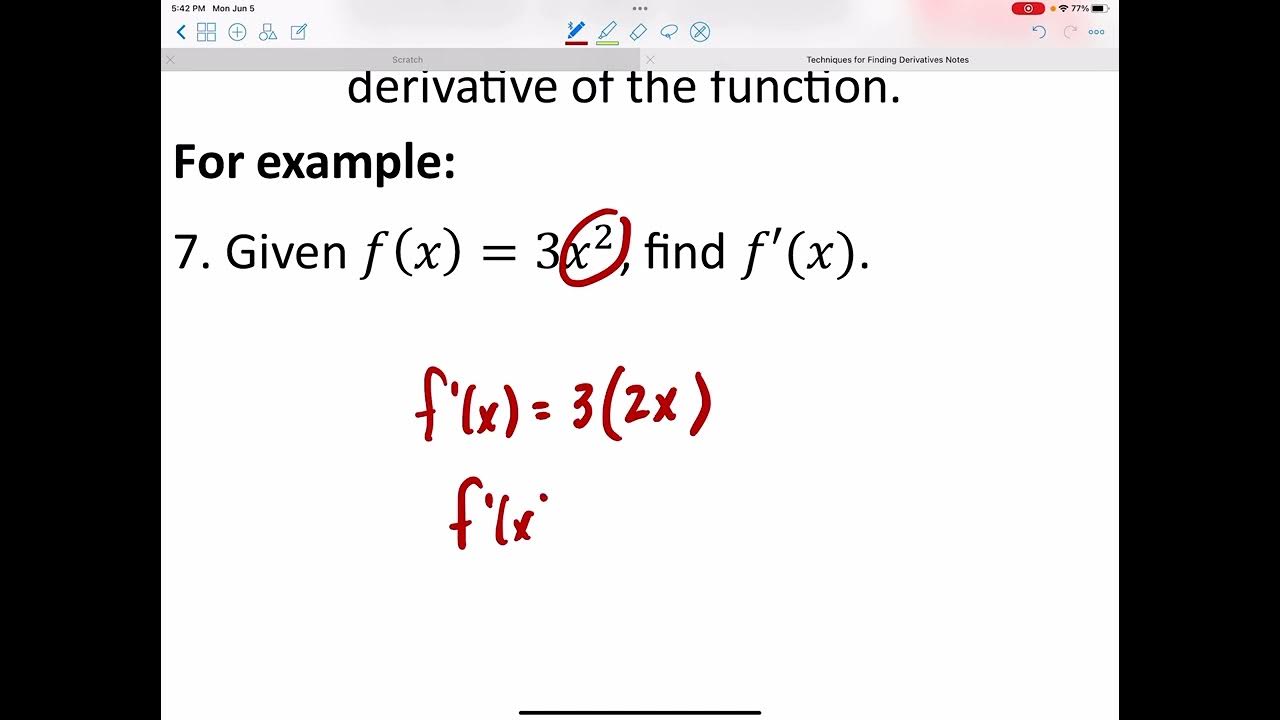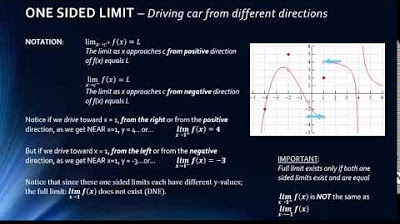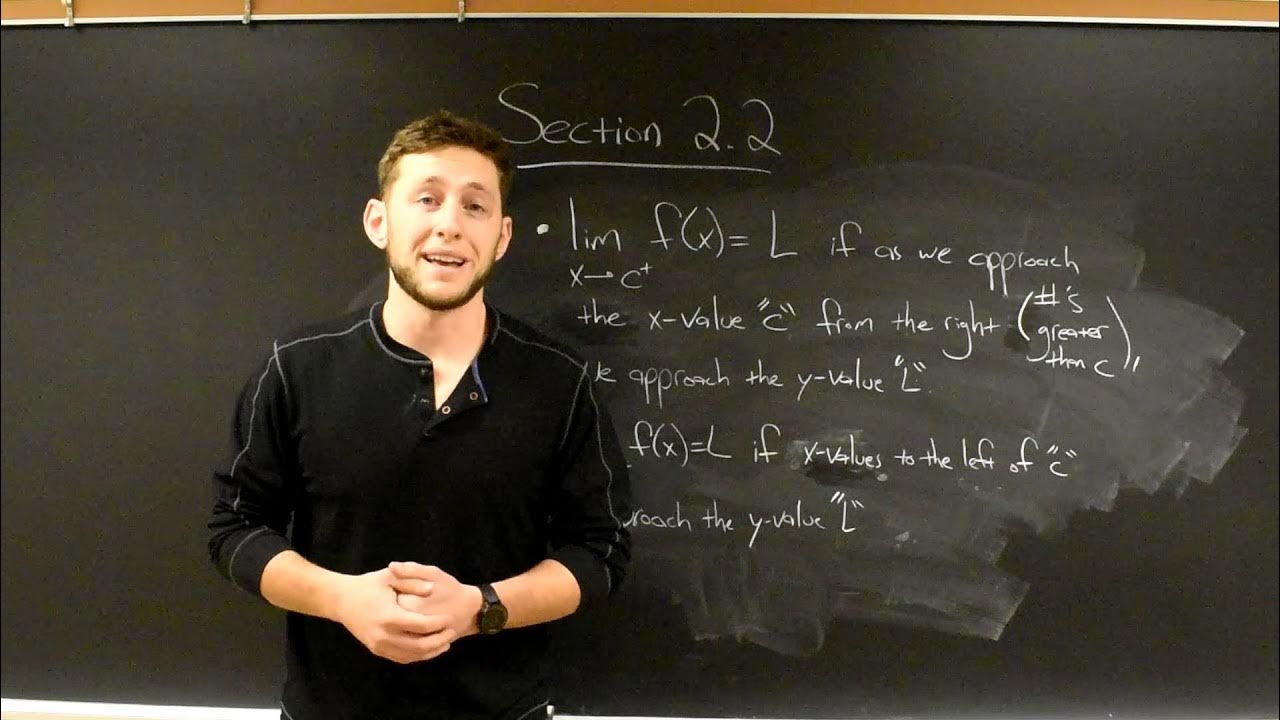Derivative notation and limits [IB Maths AI SL/HL]
TLDRThe video script delves into the fundamental concept of derivatives in calculus, emphasizing their role as a measure of change or the gradient of a tangent. It explains various notations for derivatives, such as 'y prime' and 'dy/dx', highlighting the latter as a more precise representation for functions of multiple variables. The script further explores the application of derivatives in different contexts, like physics and economics, to illustrate rates of change. Additionally, it introduces the concept of limits, demonstrating how they function in calculus through examples, including limits as x approaches a specific value and as it approaches infinity. The video concludes with a humorous math joke about limits, aiming to make the abstract concept more relatable and engaging for the audience.
Takeaways
- 📌 A derivative represents the gradient of the tangent or the rate of change of a function.
- 📝 The notation for the derivative of a function y with respect to x is often written as y', dy/dx, or f'(x), where f(x) is the function.
- 🔍 The symbol 'd' in dy/dx indicates a change in y over a change in x, emphasizing the rate of change.
- 📐 When dealing with functions of multiple variables, like y in terms of x and z, dy/dx specifically addresses how y changes with respect to x.
- 🌐 The notation for the derivative can be adapted to various contexts, such as dv/dt for velocity with respect to time or dc/dx for cost with respect to the number of products.
- ⏱️ The average rate of change is calculated by dividing the total change in y by the total change in x over an interval.
- ⚡ For instantaneous rate of change, the derivative is evaluated at a specific point.
- 💰 An example using calculus notation to determine a better rate of pay between two individuals is demonstrated.
- 📘 Limits are introduced as a fundamental concept in calculus, denoted by lim with an arrow indicating the approach to a certain value.
- ∞ The concept of infinity is explored in the context of limits, where 1/infinity is understood to approach zero.
- 🔢 The limit as h approaches zero of a function is calculated by substituting h with values that get closer and closer to zero to observe the behavior of the function.
- 🎓 A math joke is shared to illustrate the concept of limits in a light-hearted way, emphasizing the importance of understanding limits in calculus.
Q & A
What is a derivative in calculus?
-A derivative in calculus is the gradient of the tangent or the rate of change of a function concerning its variable. It represents how one variable changes with respect to another.
What are the different notations used to represent a derivative?
-Different notations for a derivative include 'y prime' (y'), 'dy/dx', and 'f'(x)' or 'f prime of x' (f'(x)). The 'dy/dx' notation is more accurate, especially when dealing with functions involving multiple variables.
How can you represent the rate of change of velocity with respect to time using calculus notation?
-The rate of change of velocity with respect to time can be represented as 'dv/dt', where 'v' stands for velocity and 't' stands for time.
What does 'dy/dx' signify in calculus?
-'dy/dx' signifies the change in 'y' over the change in 'x'. It is a way to express the rate of change of 'y' with respect to 'x'.
How does the notation 'f(x)' relate to the derivative?
-When a function is represented as 'f(x)', its derivative is denoted as 'f'(x)' or 'f prime of x' (f'(x)), which indicates the rate of change of the function 'f' with respect to 'x'.
What is the concept of average rate of change?
-The average rate of change is the total change in 'y' divided by the total change in 'x'. It provides an overall measure of how 'y' changes with 'x' over an interval.
How is calculus notation applied to compare the rates of pay for two different workers?
-Calculus notation can be used to represent the rate of pay as 'dp/dh', where 'p' is pay and 'h' is hours worked. By dividing the total pay by the total hours worked, one can calculate the rate of pay per hour for each worker.
What is the concept of limits in calculus?
-In calculus, limits are a way to describe the behavior of a function as its input approaches a certain value. The notation 'lim (x -> a) f(x)' represents the limit of the function 'f(x)' as 'x' approaches the value 'a'.
How can you find the limit of a function as 'x' approaches infinity?
-To find the limit as 'x' approaches infinity, you can consider the behavior of the function as 'x' takes increasingly large values. If the function's value trends towards a specific number, that number is the limit.
What does the notation 'lim (h -> 0) (2h/h^2)' represent, and how do you simplify it?
-The notation 'lim (h -> 0) (2h/h^2)' represents the limit of the function '2h/h^2' as 'h' approaches 0. To simplify, you can cancel out 'h' from the numerator and denominator, leaving '2/h'. As 'h' approaches 0, the expression tends towards infinity.
What is the significance of limits in understanding the concept of instantaneous rate of change?
-Limits are crucial in understanding the concept of instantaneous rate of change because they allow us to find the derivative at a specific point, which is the instantaneous rate of change of a function at that point.
Can you provide an example of a math joke related to limits?
-Yes, one math joke related to limits is about an infinite number of mathematicians walking into a bar. As each orders a drink, the amount of beer they request keeps getting halved. When the bartender sees the pattern, he brings out two beers, saying, 'Come on, guys, know your limits,' which humorously refers to the concept of limits in calculus.
Outlines
📚 Derivative Notation and Concept Explanation
This paragraph introduces the concept of a derivative as the gradient of the tangent or the rate of change. It discusses different notations used to represent derivatives, such as y' for a single-variable function, dy/dx for a more precise notation, and f'(x) when using function notation. The paragraph also touches on the application of derivatives in various fields like physics and economics, where it can represent how velocity changes with time or how cost changes with the number of products sold. It concludes with an example of calculating the rate of pay for two different workers using calculus notation.
🔍 Understanding Limits in Calculus
The second paragraph delves into the concept of limits in calculus. It begins with a simple example of the limit as x approaches 2 of x plus 3, which is straightforwardly evaluated as 5. The discussion then becomes more abstract when considering the limit as x approaches infinity, illustrating the concept with the example of 1 over a very large number approaching zero. The paragraph further explores the limit as h approaches 0 of 2h over h squared, simplifying the expression and showing that as h approaches zero, the expression tends towards infinity. A math joke related to limits is shared to lighten the mood, emphasizing the importance of understanding limits in calculus.
Mindmap
Keywords
💡Derivative
💡Notation
💡Rate of Change
💡Function
💡Limit
💡Infinity
💡Average Rate of Change
💡Instantaneous Rate of Change
💡Variable
💡Calculus Notation
💡Physical Applications
Highlights
Derivative is defined as the gradient of the tangent or the rate of change.
Notation for derivatives includes y' for single-variable functions and dy/dx for more accuracy.
The notation f'(x) is used when y is expressed as a function of x.
Derivatives can be applied to multiple-variable equations, such as dy/dx when y is a function of both x and z.
The notation dV/dt is used to represent how velocity changes with time in physics.
In economics, derivatives can be used to analyze how cost (c) changes with the number of products sold (x), denoted as dc/dx.
Average rate of change is calculated by dividing the total change in y by the total change in x.
Instantaneous rate of change is found by taking the derivative at a specific point.
Calculus notation can be applied to everyday scenarios, such as calculating the rate of pay for workers.
The limit notation lim is used to express the concept of a function's behavior as a variable approaches a certain value.
Limits can be calculated for finite values, such as lim (x -> 2) of (x + 3) which equals 5.
Understanding limits as x approaches infinity involves considering the behavior of a function as x becomes very large.
The concept of limits can be illustrated by the idea that 1/infinity approaches 0.
Limits can also be used to describe behavior as a variable approaches 0, such as lim (h -> 0) of (2h)/h^2.
A humorous math joke is shared to illustrate the concept of limits in a light-hearted way.
The joke involves an infinite number of mathematicians ordering beers in decreasing fractions, emphasizing the concept of limits.
The transcript concludes with a focus on the importance of understanding limits in calculus.
Transcripts
5.0 / 5 (0 votes)
Thanks for rating:





